In a world where the only thing scarier than a horror movie is the thought of a break-in, securing one’s home is a top priority. But who says you need to spend a fortune to keep the boogeyman at bay? Enter DIY security systems—the superhero of home protection that doesn’t require a sidekick budget. With a little creativity and some tech-savvy tools, anyone can transform their home into a fortress without losing their minds or their wallets.
Imagine installing a state-of-the-art security system while wearing pajamas and sipping coffee. It’s not just possible; it’s downright fun! From smart cameras to motion sensors, the best DIY security systems offer peace of mind and a sense of accomplishment. So, let’s dive into the world of home security that’s as easy as pie but way more effective at keeping the bad guys out.
Table of Contents
ToggleOverview Of DIY Security Systems
DIY security systems provide affordable protection for homes by allowing individuals to implement security measures themselves. These systems combine creativity with technology to create a customized security solution.
What Is a DIY Security System?
A DIY security system is a self-installed setup that includes various components like cameras, alarms, and sensors. Users can tailor these systems to their specific needs without the help of professionals. Components often connect via mobile apps, enabling monitoring from anywhere. Popular options include smart cameras that stream live video and motion sensors that alert users when movement occurs. This flexibility empowers homeowners to design systems around their unique security requirements.
Advantages of DIY Security Systems
DIY security systems offer several advantages over traditional setups. Cost-effectiveness stands out as a significant benefit, as users save on installation fees and professional monitoring services. Control and flexibility follow closely behind, allowing customization based on personal preferences and requirements. Additionally, easy installation enables users to set up systems quickly, often within a few hours. Many systems also feature intuitive apps for real-time monitoring. Lastly, the sense of accomplishment achieved through self-installation enhances the overall experience of enhancing home security.
Factors to Consider When Choosing DIY Security Systems

Selecting the best DIY security system requires careful consideration of several important factors.
Budget Considerations
Evaluate the overall budget before making a decision. Pricing for DIY security systems varies significantly based on features and brands. Affordable options exist that still provide essential security functions. Setting a budget helps narrow choices and prevents overspending. Consider ongoing costs, including subscriptions for cloud storage or monitoring services. Assess installation costs, even if the system is marketed as DIY. Ensuring that the total investment aligns with personal finances maintains financial balance.
Features and Functionality
Examine key features offered by various DIY security systems. Look for essential components like cameras, door and window sensors, and smart alarms. Motion detection capabilities enhance security, providing alerts when activity occurs. Some systems allow for remote monitoring through a mobile app, which increases convenience. Additionally, compatibility with existing smart home ecosystems is a valuable factor. Knowing the desired features helps prioritize options and streamline the selection process.
Ease of Installation
Installation simplicity significantly influences choice. Many DIY security systems feature straightforward setups with user-friendly instructions. Some systems require little more than plugging in a device and downloading an app. Consider systems that offer video tutorials or customer support for added assistance. Flexibility in placement of cameras and sensors enhances convenience. Choose systems that accommodate personal skills and comfort level, ensuring a smooth, stress-free installation experience.
Top 5 Best DIY Security Systems
These top five DIY security systems provide homeowners with both peace of mind and control over their home security.
System 1: Features and Benefits
Ring offers a user-friendly experience with its cameras and alarms. Motion detection alerts notify homeowners instantly, while two-way audio allows communication with visitors. Additionally, cloud storage options enable easy access to recorded footage. With integration into various smart home devices, this system simplifies monitoring through a single app.
System 2: Features and Benefits
Arlo features wire-free cameras that deliver 1080p HD video quality. The product includes night vision, ensuring visibility even in low-light situations. A mobile app provides real-time notifications and remote monitoring capabilities. Users enjoy flexible power options, including solar power, which enhances environmental efficiency.
System 3: Features and Benefits
SimpliSafe offers customizable security packages tailored to individual needs. The system comprises various sensors, including window and door sensors, for comprehensive coverage. Users appreciate the 24/7 professional monitoring option, adding an extra layer of security. Additionally, easy installation means homeowners can set it up without professional assistance.
System 4: Features and Benefits
Wyze Home Security presents a budget-friendly choice without compromising quality. Its all-in-one kit includes multiple sensors and cameras. Homeowners benefit from free cloud storage and live streaming features. Compatibility with Alexa and Google Assistant enhances usability, making voice commands an option.
System 5: Features and Benefits
Abode combines flexibility with advanced technology, allowing full customization. This system integrates various types of devices, such as cameras, motion sensors, and smart locks. Homeowners can monitor their property from anywhere, using a mobile app. With no contracts required, users retain control over their security arrangements.
Installation and Setup Tips
Installing a DIY security system enhances home security while providing a sense of accomplishment. Following these steps and addressing common challenges can streamline the process.
Step-by-Step Installation Guide
- Choose an optimal location for cameras and sensors, prioritizing areas with high foot traffic.
- Read the instruction manual included with the security system, ensuring familiarity with all components.
- Download the mobile app associated with the system, preparing for easy access and monitoring.
- Install cameras and sensors based on the chosen locations, securing them firmly to prevent easy tampering.
- Connect devices to Wi-Fi, allowing them to communicate effectively and transmit alerts.
- Test each component after installation for proper functionality and adjust placement if necessary.
Common Challenges and Solutions
Positioning cameras can pose difficulties. Identify blind spots and adjust placements accordingly to maximize coverage. Connectivity issues may arise due to inadequate Wi-Fi strength. Consider using Wi-Fi extenders to enhance signals in challenging areas. Battery life for devices can become a concern. Regularly check battery levels and replace or recharge as needed to ensure consistent operation. Lastly, misunderstanding app functionality is common. Utilize available online resources or customer support to gain clarity on features, ensuring effective utilization of the system.
Investing in a DIY security system empowers homeowners to take charge of their safety. With a variety of options available it’s easier than ever to tailor a system that meets specific needs. The ability to customize and install these systems not only enhances security but also provides a rewarding experience.
By considering factors like budget and essential features, individuals can find the right solution that fits their lifestyle. Whether opting for advanced technology or budget-friendly choices, DIY security systems offer peace of mind and control. Embracing this approach allows for a secure home environment without breaking the bank.
